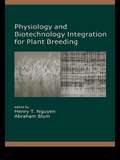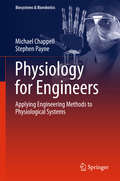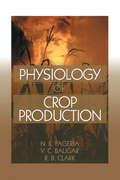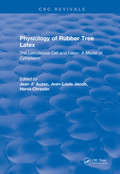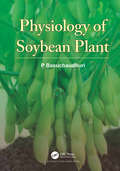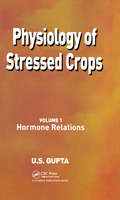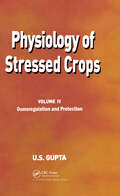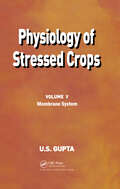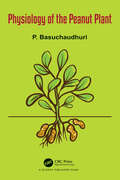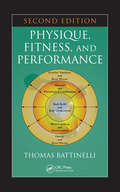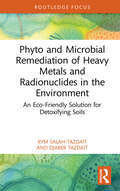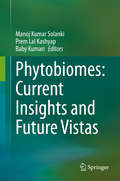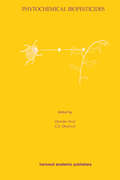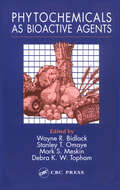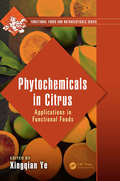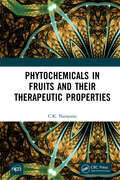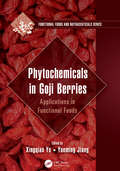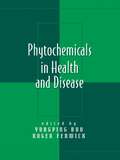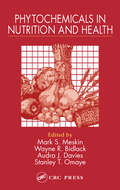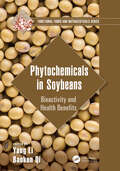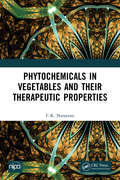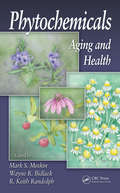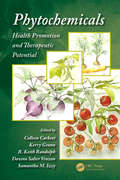- Table View
- List View
Physiology and Biotechnology Integration for Plant Breeding (Books In Soils, Plants, And The Environment Ser. #Vol. 100)
by Abraham Blum Henry T. Nguyen� Global demand for wheat, rice, corn, and other essential grains is expected to steadily rise over the next twenty years. Meeting this demand by increasing production through increased land use is not very likely; and while better crop management may make a marginal difference, most agriculture experts agree that this anticipated deficit must be m
Physiology for Engineers
by Stephen Payne Michael ChappellThis book provides an introduction to qualitative and quantitative aspects of human physiology. It looks at biological and physiological processes and phenomena, including a selection of mathematical models, showing how physiological problems can be mathematically formulated and studied. It also illustrates how a wide range of engineering and physics topics, including electronics, fluid dynamics, solid mechanics and control theory can be used to describe and understand physiological processes and systems. Throughout the text there are introductions to measuring and quantifying physiological processes using both signal and imaging technologies. Physiology for Engineers describes the basic structure and models of cellular systems, the structure and function of the cardiovascular system, the electrical and mechanical activity of the heart and provides an overview of the structure and function of the respiratory and nervous systems. It also includes an introduction to the basic concepts and applications of reaction kinetics, pharmacokinetic modelling and tracer kinetics. It is of interest to final year biomedical engineering undergraduates and graduate students alike, as well as to practising engineers new to the fields of bioengineering or medical physics.
Physiology for Engineers: Applying Engineering Methods to Physiological Systems (Biosystems & Biorobotics #24)
by Stephen Payne Michael ChappellThis book provides an introduction to qualitative and quantitative aspects of human physiology. It examines biological and physiological processes and phenomena, including a selection of mathematical models, showing how physiological problems can be mathematically formulated and studied. It also illustrates how a wide range of engineering and physics topics, such as electronics, fluid dynamics, solid mechanics and control theory can be used to describe and understand physiological processes and systems. Throughout the text, there are introductions to measuring and quantifying physiological processes using both signaling and imaging technologies. This new edition includes updated material on pathophysiology, metabolism and the TCA cycle, as well as more advanced worked examples. This book describes the basic structure and models of cellular systems, the structure and function of the cardiovascular system, and the electrical and mechanical activity of the heart, and provides an overview of the structure and function of the respiratory and nervous systems. It also includes an introduction to the basic concepts and applications of reaction kinetics, pharmacokinetic modelling and tracer kinetics. It appeals to final year biomedical engineering undergraduates and graduates alike, as well as to practising engineers new to the fields of bioengineering or medical physics.
Physiology of Crop Production
by N.K. Fageria V.C. Baligar Ralph ClarkThis single volume explores the theoretical and the practical aspects of crop physiological processes around the world The marked decrease over the past century in the land available for crop production has brought about mounting pressure to increase crop yields, especially in developing nations. Physiology of Crop Production provides c
Physiology of Rubber Tree Latex: The Laticiferous Cell and Latex- A Model of Cytoplasm
by J. d'AuzacThe present work is based on the study of the laticiferous system in Hevea. It therefore covers anatomical, histological, and cytological research on laticifers and latex, together with biochemical and enzymological investigation of latex in vitro. Integration of all these studies led to the investigation of the physiology of the laticiferous function. The work described includes the most important results obtained over a period of nearly a century and the most recent work which has yet to be published.
Physiology of Soybean Plant
by P BasuchaudhuriThe book provides in-depth knowledge on the physiology of soybean. It is written lucidly, systematically, and in depth. The book provides recent information and findings, explained with illustrations to express the ideas and concepts vividly to university students and researchers, and provides a better understanding of the improvement of the productivity of soybean to cope with the future demand. It describes the physiology of growth, development, flowering, pod development and seed yield as well as C, O, N and Oil metabolisms – their hormonal regulations under normal and stress environmental conditions. Molecular approaches are also described.
Physiology of Stressed Crops, Vol. 1: Hormone Relations
by U S GuptaThe present multi-volume treatise has been planned to discuss important aspects of the crop-plant physiological aspects, viz., hormones, nutrients, cell membranes, and induced proteins, as related to different types of stresses each in separate volumes. Another type of stress which can be classed under biotic, environmental (sil) or chemical, viz., the stress of allelochemicals which has not been discussed before as a stress factor, will be discussed in a separate volume emphasizing its practical/ ap-plied aspects, rather than mentioning only the allelopathic effects. In this volume on Hormone Relations, different stresses have been arranged in order of their importance and work done.
Physiology of Stressed Crops, Vol. 4: Osmoregulation and Protection (Physiology of Stressed Crops)
by U S GuptaTo cope with the abiotic stress-induced osmotic problems, plants adapt by either increasing uptake of inorganic ions from the external solution, or by de novo synthesis of organic compatible solutes acting as osmolytes. Of the osmoregulants and protectants discussed in this volume, trehalose, fructans, ectoine and citrulline, which are generated in different species, in osmotically ineffective amounts, mitigate the stress effects on cells/plants and improve productivity. There are several pieces of encouraging research discussed in this volume showing significant improvement in stress tolerance and in turn productivity by involving genetic engineering techniques.
Physiology of Stressed Crops, Vol. 5: Membrane System (Physiology of Stressed Crops)
by U S GuptaThough plant cells are separated by cell walls, cells maintain their identity as they are delimited by semi-permeable membranes that permit them to function as autonomous units. The flow of materials in and out of the cell is regulated by channels, transporters, pumps, and acquaporins in these membranes. The cytoplasm is sandwiched between two membranes: the plasma membrane, which forms the outer boundary of the cytoplasm, and the tonoplast or the vacuolar membrane which forms the inner boundary. Cell membranes serve several different functions: form boundaries and provide compartmentalization, site of chemical reactions catalyzed by membrane proteins, regulate the exchange of ions/compounds across the barrier, site of perception/transmission of signals (hormones), and act in cell-to-cell communication.The membrane functions are affected by different abiotic (biotic stress not discussed), nutritional, edaphic and mechanical stresses, which have been discussed in this volume in light of the recent literature
Physiology of the Peanut Plant
by P BasuchaudhuriPeanut is an important crop in the semi-arid regions of the world. Both, irrigation and well water can provide the water necessary for it. It is a nutritious seed nut crop and has manyfold uses. As such, research on this crop is imperative. This book reviews physiological aspects, keeping in mind the changing agroclimatic conditions. Growth, development and yield are described on the basis of cellular and morphological manifestations. Being a C3 plant, the photosynthesis and respiration in peanuts is critically viewed specially under varying environment conditions and genotypes. The study of nitrogen assimilation and biological nitrogen fixation have been presented in light of the prevalent environmental and gene effects. The role of plant growth regulators in peanuts is elaborated on, stating up-to-date mode of actions. Special emphasis has been given to mechanisms of abiotic stress effects. The chapters (13) are arranged on the basis of physiology, cellular structure, biochemistry, molecular and genomics concepts.
Physique, Fitness, and Performance (Exercise Physiology)
by Thomas BattinelliTotally revised and updated, this second edition of the well-received Physique, Fitness, and Performance retains the unique integrated approach of its predecessor, examining the relationship of structure to function in human performance. Far surpassing the limited focus of standard exercise and fitness books, it combines the morphological study of
Phyto and Microbial Remediation of Heavy Metals and Radionuclides in the Environment: An Eco-Friendly Solution for Detoxifying Soils (Routledge Focus on Environment and Sustainability)
by Rym Salah-Tazdaït Djaber TazdaïtThis book examines the role that bioremediation can play in the detoxification of soil, water, and air to improve environmental and human health, with a specific focus on heavy metals and radionuclides. Environmental pollution, whether by natural or human causes, with industrial activities being a key player, is a challenge facing all nations across the world. While treatment has typically required the use of expensive technology, one promising solution is the use of phytoremediation, in which plants act by metabolizing or sequestering pollutants. This eco-friendly solution is a good alternative to the standard methods of soil and water treatments. This book provides not only the basic definitions and classification of technologies used for contaminant remediation but also the most recent studies dealing with the selection of new promising microbial stains and plant varieties involved in the treatment of radioactive and heavy metal contaminants. It provides a detailed description of the biochemical mechanisms and genes involved in the bioremediation of radionuclides and heavy metals, offering a clear insight for academics and practitioners interested in in vitro and in situ biological treatment. This book will be of great value to students and scholars interested in environmental pollution and environmental health from across a range of different disciplines, including environmental microbiology and chemistry, ecology and environmental science, biological and environmental engineering and biotechnology.
Phyto and Rhizo Remediation (Microorganisms for Sustainability #9)
by Narendra Kumar Naveen Kumar AroraThe increasing human population and the associated activities have negatively influenced the ecosystems and life on earth. The continuous addition of agrochemicals, heavy metals and industrial wastes/ effluents in the ecosystems have caused great harm, including loss of productivity, biodiversity, climate change and diseases in plants, animals and humans, resulting in increased marginal lands and endangered sustainability of life on earth. Hence, there is an urgent need to reverse the impact of dangerous pollutants through a holistic, sustainable and biotic approach. Bioremediation involves the utilization of biological systems, mainly plants (phytoremediation) or microorganisms or both in combination (rhizoremediation) for the removal or degradation of pollutants and revive the habitats in an eco-friendly manner. Recently, there have been many success stories related to bioremediation involving plants or plant-microbe interactions. These success stories are related to the removal of heavy metals, pesticides, polyaromatic hydrocarbons, explosives, radionuclides or reduction of biological oxygen demand, total dissolved solids, total suspended solids, oil spills in water bodies. Rhizoremediation has also been successfully used for reclamation of saline or marginal soils. With the range of pollutants and the total area (on earth) covered by these toxic chemicals, it is important that these eco-friendly technologies be utilized in a better way. The book throws light on the recent happenings, research and success stories related to bioremediation of polluted habitats through phytoremediation or rhizoremediation. The book also highlights some of the significantly important plant and microbial species involved in remediation, the physiology, biochemistry and the mechanisms of remediation by various plants and microbes, and suggestions for future improvement of bioremediation technology.
Phytobiomes: Current Insights and Future Vistas
by Prem Lal Kashyap Manoj Kumar Solanki Baby KumariTo satisfy the food demands of the global population, advanced technology based research is needed, that can extract the information from the plant metabolism and microbial gene pool and use it for improving plant health and productivity. Modern biotechnological tools have the ability to unlock the limitations of agricultural practices. However, the application of these tools is not well equipped. Moreover, eco-friendly agriculture by microbial inoculants is known to have positive influences on soil/plant health. Therefore it is relevant to explore the plant associated microbial niches, especially endophytes, epiphytes, and soil microbes and understand how they are benefitting each other. It can open new insights to develop sustainable agriculture practices by using consortia of microbes as plant helpers that recover the imbalanced agriculture systems and manage pathogenic diseases. This book presents the updates about the plant associated microbiomes and their contemporary uses. It covers the knowledge gap between soil and plant helper microbiomes and their application in the agriculture and allied sectors. Modern insights of phytobiomes are explored in various chapters on a variety of interrelated aspects of the fascinating areas like plant microbial interaction, integrated pest management, soil fertility intensification, sustainable crop production, and disease management. Sections in the book describe how to plant beneficial microbiomes have been utilized for sustainable green farming, with the aim to resolve the global food problem without harming the soil and environment health. This book is intended for everyone who is involved in agriculture, microbial biotechnology, bioinformatics, and all disciplines related to microbial biotechnology. These include academic students, scientists, and researchers at universities, institutes, industries, and government organizations who want to understand microbial linkages in a shorter time. It contains basic information that will be help to the non-specialist readers to understand progressive research.
Phytochemical Biopesticides
by Opender Koul G. S. DhaliwalIn recent years, the development of biological pest control strategies has focused on the chemical profiles of insect-plant interactions. Plants exhibit an extensive range of defensive strategies, which include insect avoidance, deterrence and antibiosis. The need to overcome these vegetative defence responses has driven the evolution of an array o
Phytochemicals as Bioactive Agents
by Mark S. Meskin Wayne R. Bidlack Stanley T. Omaye Debra K. W. TophamPhytochemicals as Bioactive Agents focuses on the mechanisms of action of phytochemicals identified as displaying bioactivity in the prevention of cancer, heart disease and other diseases and the prospects for developing functional foods containing these bioactive compounds. Internationally recognized experts present the latest research findings on the antimutagenic and anticarcinogenic effects of tea and tea constituents; chemoprevention provided by plants in the family Cruciferae and genus Allium; anticarcinogenic effects of carotenoids and curcumins; the chemistry and application of alfalfa saponins; the bioactive components of rice bran and rice oil; the effects of garlic on lowering serum cholesterol; and using phytochemicals to optimize gastrointestinal tract health and function.
Phytochemicals in Citrus: Applications in Functional Foods (Functional Foods and Nutraceuticals)
by Xingqian YeCitrus fruits have long been popular around the world due to their good flavor, taste, high nutritional value, and their healthy properties. Citrus is well known as a rich source of vitamin C. Citrus fruits also contain many other functional bioactive phytochemicals including terpenoids, triterpenes, flavonoids, amino acids, phenolic acids, mineral constituents, and polysaccharides, which are beneficial to human health. Citrus fruits are generally recognized as an outstanding source of biologically active compounds related to both nutritional and nutraceutical values. Phytochemicals in Citrus: Applications in Functional Foods focuses on up-to-date information on chemical properties of citrus fruits, citrus food products, and their health benefits. The 16 chapters in the book provide a knowledge base on the chemical composition, bioactive components, biochemical properties, food use, and health benefits of citrus fruits. The information in this book will help readers to better understand the health benefits of citrus fruits and products and their dietary applications. The book is a unique reference for food science professionals engaged in functional foods and nutritional dietary management. The book can also serve as a handy reference for college and university students majoring in food science, nutrition, pharmaceutical science, and horticultural science.
Phytochemicals in Fruits and their Therapeutic Properties
by C.K. NarayanaThe book provides facts of fruits and their role in curing of diseases with cell line or animal studies and their pharmacological evidence would help the readers to understand the subject in greater depth. It provides information on the subject and will help researchers to carry the interest forward. The book links the traditional knowledge available on each fruit crop regarding their curative properties and the information on their scientific validation. The contents have been organized crop wise in a logical sequence, with references been provided at the end of each chapter for further reading and better understanding of the subject.The book will help the students/ researchers/ scientists and common man alike to look at the fruits as protective foods not just because it is said so, but with a scientific explanation.Note: T&F does not sell or distribute the hardback in India, Pakistan, Nepal, Bhutan, Bangladesh and Sri Lanka. This title is co-published with NIPA.
Phytochemicals in Goji Berries: Applications in Functional Foods (Functional Foods and Nutraceuticals)
by Xingqian Ye and Yueming JiangGoji berries (Lycium barbarum), which are widely distributed in Northwestern China, Southeastern Europe and the Mediterranean areas, have traditionally been employed in Chinese medicine from ancient times. Goji berries, also known as wolfberry, have become increasingly popular in the Western world because of their nutritional properties, often advertised as a superfood in Europe and North America. With the development of analysis methods, various chemical constituents have been identified, including carbohydrates, carotenoids, flavonoids, betaine, cerebroside, -sitosterol, amino acids, trace elements, vitamins and other constituents. Polysaccharides have been identified as one of the major active ingredients responsible for biological activities. Phytochemicals in Goji Berries: Applications in Functional Foods, a volume in the Functional Foods and Nutraceuticals Series, provides information about the chemical, biochemical, botanic properties, bioactive components and health benefits of Goji berries. It also discusses postharvest storage technology, processing technology, and the development and utilization of Goji berry by-products in medicinal foods and functional foods, as well as addressing food safety issues. Features: Provide information on Goji fruit origin and growing conditions, distribution, and biochemical properties Discusses such medicinal properties and health benefits of Goji berries as the capacity to lower blood pressure, treat anemia, maintain cholesterol levels in the normal range and decrease risk of cardiovascular disease. Additionally, Goji berries have anti-inflammatory and anti-tumor properties, among others Includes information on traditional products, new products and innovative processing technologies This book will serve college and university students majoring in food science, nutrition, pharmaceutical science, and botanical science. It also will serve as a unique reference for food science professionals pursuing functional foods, marketing expansion, as well as nutritional dietary management. Readers will obtain sound scientific knowledge of the nutritional value and health benefits of the different Goji berry products such as juice, cake, soup, snacks, and medicinal foods. Also available in the Functional Foods and Nutraceuticals series: Korean Functional Foods: Composition, Processing and Health Benefits, edited by Kun-Young Park, Dae Young Kwon, Ki Won Lee, Sunmin Park (ISBN 978-1-4987-9965-2) Phytochemicals in Citrus: Applications in Functional Foods, edited by Xingqian Ye (ISBN 978-1-4987-4272-6) Food as Medicine: Functional Food Plants of Africa, by Maurice M. Iwu (ISBN 978-1-4987-0609-4) For a complete list of books in the series, please visit our website at https://www.crcpress.com/Functional-Foods-and-Nutraceuticals/book-series/CRCFUNFOONUT
Phytochemicals in Health and Disease (Oxidative Stress And Disease Ser. #Vol. 12)
by Yongping Bao Roger Fenwick"� well-written and the content is clearly presented. � There are plentiful figures and tables, which are effectively labeled and adequately support the content. �highly recommended for academic and special libraries. �effectively presents current research on phytochemicals in a readable manner."- E-Streams "This landmark volume shows h
Phytochemicals in Nutrition and Health
by Mark S. Meskin Wayne R. Bidlack Stanley T. Omaye Audra J. DaviesAre soy isoflavones neuroprotective? Just how different is one species of Echinacea from another? Which phytochemicals will be effective as therapeutic agents in vivo? Supported by solid scientific research, Phytochemicals in Nutrition and Health helps provide answers to these and other probing questions concerning the mechanisms of action associat
Phytochemicals in Soybeans: Bioactivity and Health Benefits (Functional Foods and Nutraceuticals)
by Yang Li and Baokun QiSoybeans represent an excellent source of high-quality protein with a low content in saturated fat. They can be made into various foods, such as tofu, miso, breakfast cereals, energy bars, and soy cakes. Much research has been carried out on the positive health effects of soybeans, and increasing evidence shows that consumption of soybeans may reduce the risk of osteoporosis, have a beneficial role in chronic renal disease, lower plasma cholesterol, and decrease the risk of coronary heart disease.Phytochemicals in Soybeans: Bioactivity and Health Benefits describes in detail the chemical characteristics of health-promoting components of soybeans and soybean products, their impacts on human health, and emerging technologies about soybean processing and new products. With 22 chapters containing the most recent information associated with soybean products, topics of the chapters include soybeans’ role in human nutrition and health, their composition and physicochemical properties, action mechanism of their physiologic function, processing engineering technology, food safety, and quality control. Key Features: Promotes soybean products as functional food with advanced processing technology Presents the basic research containing the experimental design, methods used, and a detailed description of the results. Provides a systematic approach to the subject to facilitate a better comprehension of the subjects with illustrations and diagrams Includes a comprehensive and up-to-date list of references With contributions from authors around the world who are experts in their field, this book contains new information on the health impacts of soybean consumption, new product development, and alternative technologies of soybean processing, and will be useful for professors and researchers, as well as graduate and undergraduate students alike.
Phytochemicals in Vegetables and their Therapeutic Properties
by C.K. NarayanaThis book contains information on plant-based nutrients and phytochemicals in vegetable crops that are commonly consumed. The information generated by researchers using modern methods of biochemical analysis and results, mostly validated using cell line cultures or animal models, and to a limited extent on human volunteers have been presented. The vegetable crops have been grouped based on the family they belong to, because most often members of the same family have similar biomolecules as active ingredients and have similar effects on health. The book will help students/researchers/scientists and common man alike to look at the vegetables as protective foods, not just because it is said so, but with a scientific explanation.Note: T&F does not sell or distribute the hardback in India, Pakistan, Nepal, Bhutan, Bangladesh and Sri Lanka. This title is co-published with NIPA.
Phytochemicals: Aging and Health
by R. Keith Randolph Mark S. Meskin Wayne R. BidlackThe fastest growing demographic in both developed and developing societies around the world, the elderly bring unique medical and financial health-care burdens. In response to this phenomenon, a large and growing body of research is directed toward the science of healthy aging. A substantial amount of observational data points to the consumption o
Phytochemicals: Health Promotion and Therapeutic Potential
by Colleen Carkeet Kerry Grann R. Keith Randolph Dawna Salter Venzon Samantha M. IzzyIncreasing knowledge of the various protective effects of phytochemicals has sparked interest in further understanding their role in human health. Phytochemicals: Health Promotion and Therapeutic Potential is the seventh in a series representing the emerging science with respect to plant-based chemicals. Drawn from the proceedings at the Seventh In
